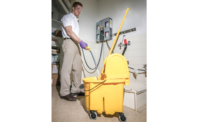When it comes to green buildings, much thought often goes into the building envelope, the HVAC systems, solar panels, daylighting and other high-profile areas.
But what about the components that are not as visible? Though they remain largely unseen behind the walls, piping systems play an essential role in the day-to-day operation of a building — and are an integral part in achieving green design goals. Choice of piping touches several aspects of sustainability, including occupant health, resource management and even energy use.
Life-cycle assessment
Life-cycle analysis provides a complete look at the environmental impacts of a product or system from raw material extraction through production, use and, finally, end of life. By including the use phase of a product’s life into this analysis, one can make specific comparisons based on a product’s application. It is a time-consuming process for raw-material producers and manufacturers, but it enables environmental impacts to be weighed among products of similar applications. In other words, it allows product specifiers to make apples-to-apples comparisons of products, weighing the environmental or human health attributes of one product clearly and legitimately against another in order to select the material most in line with chief project goals.
Lubrizol recently completed a life-cycle assessment for FlowGuard piping systems globally, including sister brands FlowGuard Gold pipe and fittings and Corzan piping systems. The result is a baseline report that assesses the cradle-to-grave environmental impacts of the system, including the raw materials, manufacturing, transportation, use and end-of-life stages. The evaluation was conducted by third-party agency Environmental Resources Management (ERM) and was peer reviewed by Dr. Walter Klöppfer, editor-in-chief of the International Journal of Life Cycle Assessment.
The LCA, which conforms to ISO 14040 and 14044 standards, outlines the environmental impacts of the piping systems compared to other materials.
Based on the LCA, ERM wrote a report comparing the products’ environmental impacts to those of copper. The cradle-to-gate comparison analyzed impacts through the production of pipe.
Energy efficiency: The manufacture of the CPVC piping material requires less energy and produces fewer greenhouse gas emissions than other piping materials, as reported in “Life Cycle Inventory of the Production of Plastic and Metal Pipes for Use in Three Piping Applications,” a report in the Journal of Cleaner Production. Also, since these plastic pipes and fittings do not corrode, they likely are to last longer, reducing the need for replacement materials.
Material efficiency/recycling: In consideration of the circular economy — a key factor in modern sustainability efforts — CPVC can be recycled at the end of its life, such as for drainage piping or window profiles. It also can be ground into pellets and granules for use in many products, such as floor fillings/coatings, speed bumps and car mats.
LEED
For projects seeking LEED v4 BD+C certification, CPVC piping systems can contribute toward credits under several headings. Several of these are enabled by the availability of a life-cycle assessment.
-
Specifiers can earn 1 point for including at least 20 products from 5 different manufacturers with disclosure material consisting of a product-specific declaration, an EPD or a USGBC-approved program.
-
Specifiers can earn 1 point for using products that comply with one of several criteria for 50%, by cost, of the total value of permanently installed products in the project. Structure and enclosure materials may not constitute more than 30% of the value of compliant building products.
-
Specifiers can earn 1-to-2 points by using recycled and/or salvaged nonhazardous construction and demolition materials.
-
Specifiers can earn 2 points by specifying substitutes for material manufactured with lead and cadmium.
-
Specifiers can earn 1 point by using at least 5 different permanently installed products from at least 2 different manufacturers with validated hazard assessment and exposure for each substance.
-
Specifiers can earn 1 point by using at least 3 different permanently installed products that have a documented qualitative analysis of the potential health, safety and environmental impacts of the product in 5 stages of the product’s life-cycle (product assembly/manufacturing, building product installation, product use, product maintenance, end of product life/reuse).
Water quality
As material health gains greater attention in sustainability circles, it’s important to note the relationship between pipe materials and the presence of harmful bacteria. Of particular note for sustainably built projects: there is rising evidence that the lower flows from water-conserving fixtures may contribute to the formation of biofilm that provides opportunity for bacteria growth.
With water flow rates significantly lower than pre-conservation levels, water is staying in pipes longer. Longer residence time means opportunity for chlorine residuals to dissipate.
Without chlorine residuals, biofilm growth can occur, serving as a safe harbor for bacteria. Along with low flows, similar scenarios occur due to dead legs, stagnated water and lower building water-operating temperatures.
Biofilm, a slimy glue-like substance that can harbor bacteria such as Legionella and E. coli, forms on piping materials when biomass adhere to surfaces in wet conditions and provides the bacteria protection from elevated temperatures and typical water-treatment methods.
These issues are in addition to other pipe-material factors that contribute to biofilm and bacteria growth, such as surface roughness, as well as characteristics that impact how a pipeline handles sanitization and temperature treatments once bacteria are detected.
Because biofilm is what provides a safe harbor for Legionella growth, it’s also vital to be aware of design and material options that create biofilm-friendly environments. A contributing factor to the harboring development of biofilm on pipe walls is surface roughness: pipe materials with a smoother surface have less potential for biofilm growth.
CPVC and PEX are two of the smoothest, with consistent surface roughness of 12.1 micrometers and 13.7 micrometers, respectively. Copper starts smooth at 7.9 micrometers but as it ages it becomes rougher (to 2,600 micrometers), dramatically increasing its biofilm growth potential, according to a Lubrizol report entitled “Surface Profile Characterization of Various Pipes.”
Treatments recommended for disinfection also can have an impact on pipe material. Disinfection calls for high levels of chlorination and temperatures of 158° F or higher, which not all pipe materials are rated to withstand.
CPVC is naturally chlorine-, chloramine- and chlorine-dioxide resistant. Copper’s resistance to corrosion is dependent on the formation of a passivating oxide layer; however, the stability of this layer inside a pipe is dependent on the properties of the water flowing through it, such as pH and temperature. Polyolefins (polypropylene, PEX and polybutylene) require antioxidants to protect against chlorine and disinfection byproducts such as hypochlorous acid. Polypropylene manufacturers strictly recommend against use with chlorine dioxide; per the Plastic Pipe Institute’s technical note, TN-53, PEX is not recommended for service with chlorinated water above 140° because it can greatly reduce the service life of the tubing.
When designing plumbing systems, considerations of biofilm growth potential, disinfection treatments, temperatures and piping materials all need to be considered.
As water conservation issues continue to take center stage, it’s vital to monitor how lower flows can contribute to biofilm formation and how that formation can further be exacerbated by design and material options.
This, combined with leveraging the knowledge and product transparency opportunities brought by LCAs, can help specifiers make more informed decisions and ensure piping systems play an integral role in achieving sustainability objectives.
This article was originally titled “The role of piping systems in sustainable building practices” in the June 2018 print edition of PM Engineer.




